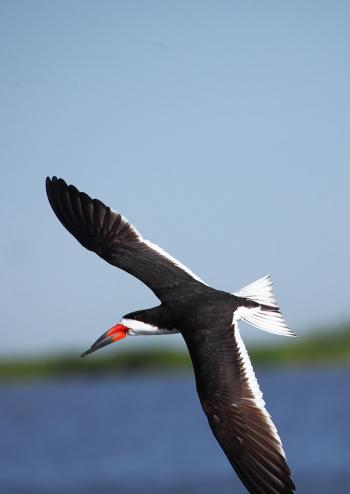
The black skimmer is considered a bird of conservation need (Submitted Photo/Courtesy of John K. Flores)
Platte Bayou rookeries are things that matter
All too often it’s the little things that go unnoticed. And, all too often it’s those little things that matter so much. The Bayou Platte Waterbird Rookery Restoration Project on Marsh Island Refuge is one of those things.
Through a grant made available by the Shell Marine Habitat Program and National Fish and Wildlife Foundation, the Coastal and Non-game Resources Division of the Louisiana Department of Wildlife and Fisheries began restoring two artificial islands located in Platte Bayou on the inside of Marsh Island in August 2013.
Originally created some 26 years ago for the purpose of establishing colonial sea bird rookeries, the two small islands, as a result of subsidence and erosion, deteriorated to the point where productivity had declined.
What makes the artificial islands so important is they are critical habitat for colonial birds that are considered species of conservation need.
Louisiana Department of Wildlife and Fisheries biologist Tyson Crouch works for the department’s Coastal Operations and Marsh Management Division. The restoration of the artificial islands is a project that Crouch has been involved in since it started.
“Black Skimmers and gull-bill terns are two species of conservation need,” Crouch said. “We also have least terns that use these islands, and they, too, are a bird of conservation need. So, these islands are very important.
“We have very few nesting areas for these birds in coastal Louisiana, and we actually had practically none in this area,” Crouch said. “The Vermillion and Cote Blanch Bay area has no real rookery of any kind. And these two islands that we have in Bayou Platte are the largest artificial islands for nesting.”
Gull-billed terns and black skimmers were a species of birds highly sought after in the New England states during the late 1800s for their eggs as a food delicacy and feathers for fashionable hat plumes. In an article written by Jim Daniel and published on www.ncwildlife.org titled, “The Plume Hunters,” it was noted that during two afternoon walks in New York City in 1886, ornithologist Frank M. Chapman, was able to identify bird’s plumage residing on 77 percent (543 of 700) of women’s hats.
An American Bird Conservancy report titled, “Status of Black Skimmers – Biological Review,” published in 2011 discussed the species plight in the state of Florida.
Essentially, black skimmers and other sea birds such as terns, gulls, and various plovers are beach-obligate species. The obstacles that skimmers and all of these birds face are development, recreation, pollution, climate change, coastal engineering projects and invasive species.
The status report says in places like Florida, where high recreational activity occurs, most colonies of birds would fail without management. Things like beach raking, ATV and automobile driving, cats and dogs, all have an impact on colonial sea bird populations.
Skimmers typically begin nesting around Memorial Day through the 4th of July. This is peak recreation periods along the United States coastlines. Florida’s coastal population is currently estimated at 12.3 million people and predicted to double to 26 million by 2060.
An Executive Summary published by the LSU Economics & Policy Research Group titled, “Economic Evaluation of Coastal Land Loss in Louisiana,” states that since 1932 through 2010, Louisiana has experienced a land loss of approximately 1,880 square miles. The report predicts the possibility of an additional 1,750 square miles by 2060.
After the initial construction phases that included dredging in situ materials to raise and expand the islands in Platte Bayou, the following spring of 2014 skimmers and terns showed up causing a work stoppage.
Crouch said, “We literally had birds nesting at the foot of equipment. So, we left them alone and came back in November and worked through the fall and winter and finished up construction in late April 2015. Our initial goal was nesting habitat for about 500 pairs. Collectively on both islands, we have approximately 2000 pairs.”
With the loss of nesting and foraging habitat, some species of sea birds are in decline with others holding their own. Conservation need doesn’t mean certain species of birds are threatened or endangered, but bear watching to ensure they continue to thrive under present conditions.
“That’s something we recognize with these islands,” says Crouch. “As the coastline erodes, these artificial islands are going to have significant usage. Marsh Island is very unique in that there really is no other large island like this. It provides habitat for hundreds of species of animals ranging from fisheries to mammalian.”
In an effort to minimize a public presence, the LDWF limits access to the two artificial islands. Signage is posted on pylons in clear view that restricts boat traffic beyond a certain point.
The size of the two Platte Bayou artificial islands is 1 and 4 acres in size respectively — hardly noticeable. But then they are one of those little things that matter so much …
EDITOR’S NOTE: John K. Flores is The Daily Review’s Outdoor Writer. If you wish to make a comment or have an anecdote, recipe or story you wish to share you can contact Flores at 985-395-5586, or gowiththeflo@cox.net or see him on Facebook at gowiththeflo outdoors.
- Log in to post comments
